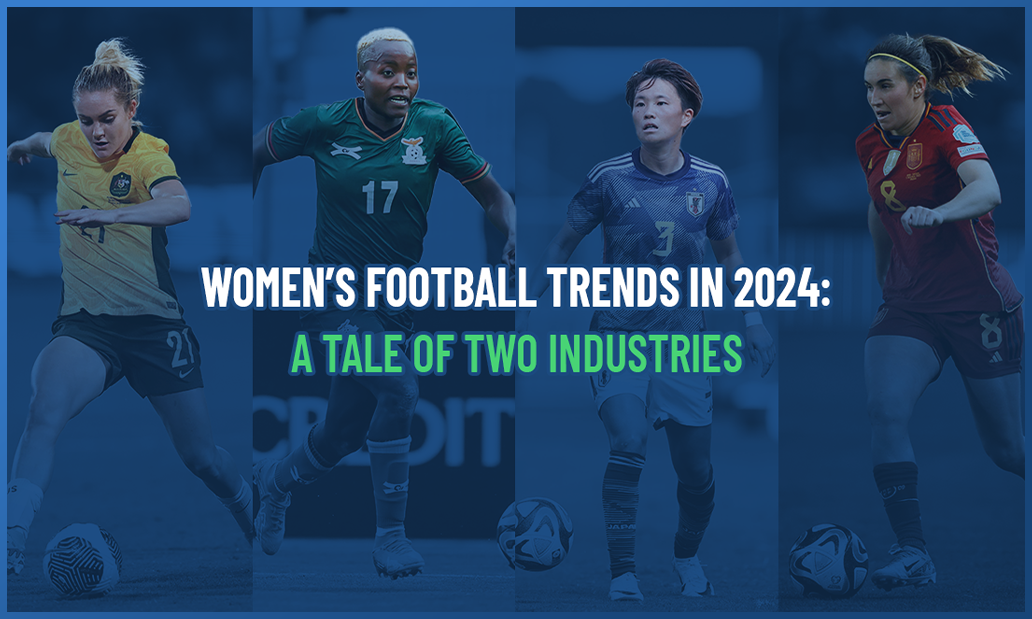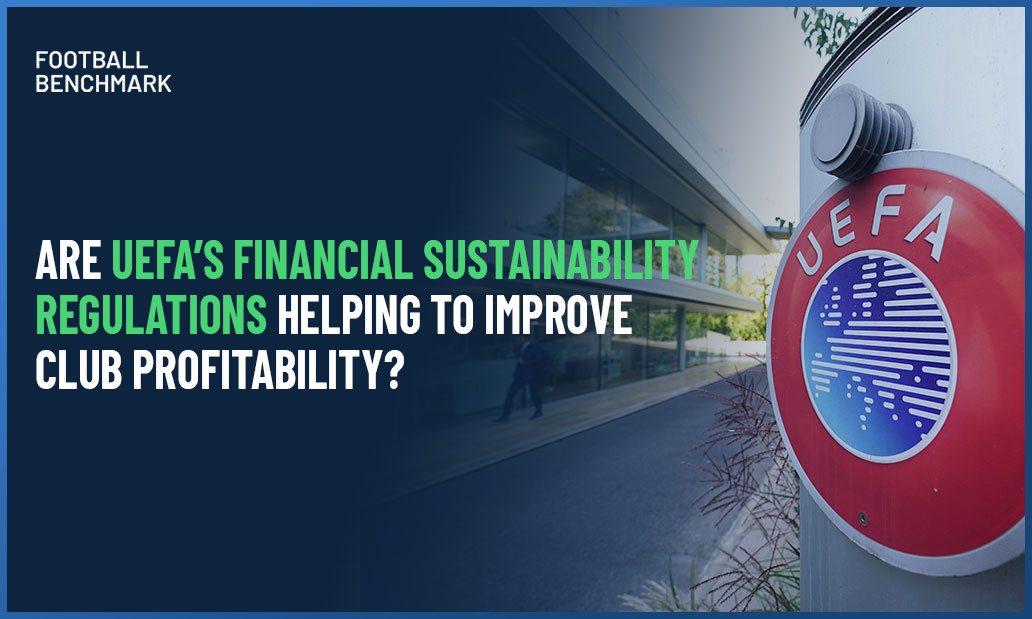
In our first article of 2025, let’s look back and recap key milestones and events of 2024 in professional women’s football. As the game grows with every passing year, it is important to recognize trends that shape the industry. One of them was also the focus of a recent study published by FIFPRO and co-written by Football Benchmark. A peculiar duality is still present: while elite women’s players face an increasingly higher workload, many others’ development is still hamstrung by “underload”.
Key insights
- 2024 featured several important milestones for the development of women’s professional football. New competitions were announced, financial incentives were increased, and player well-being policies were introduced in places.
- Despite gradual improvements, major issues persist that could hinder progress. One of the most important ones is related to a peculiar duality: high-usage elite players are being squeezed consistently with more workload, whereas the majority of players still do not get enough playing time and thus experience underload.
- Workload disparity was the overarching theme of the recent joint report by FIFPRO and Football Benchmark. Key findings from the ‘From High-Usage to Underload: A Tale of Two Industries’ study are explored in this article.
Women’s Football - 2024 Overview
As the final whistle blew on the 2024 women’s football calendar, it was clear that the development of the sport once again made great strides. Here’s a look back at a transformative year.
Paris 2024 Olympics: The year was not without a major national team tournament as 12 nations from six confederations played in the Summer Olympic Games in Paris. The US team (USWMNT) secured a record-extending fifth Olympic gold medal with a 1-0 victory over Brazil, marking a historic achievement in the sport. This came in the wake of their disappointing 2023 World Cup campaign that ended in the Round of 16.
Updated FIFA Maternity Protocols: FIFA updated its maternity protocols for players and coaches, providing increased protection during and after pregnancy and expanding support for non-biological motherhood, ensuring greater inclusivity in the sport.
FIFA Women’s Club World Cup Announcement: FIFA announced the inaugural Women’s Club World Cup, scheduled to take place in January and February 2026. The tournament will feature 16 teams and take place every four years, signifying a major step toward globalizing women’s club football and providing international club matches for more players.
Increased Prize Money for UEFA Women’s EURO 2025: UEFA announced a 156% increase in prize money for the UEFA Women’s EURO 2025, totaling EUR 41 million. Additionally, 30%-40% of the rewards will be distributed to players, and club benefit payments will rise to EUR 6 million.
UEFA’s New Women’s Football Strategy: Unstoppable: In late 2024, UEFA launched ‘Unstoppable’, a six-year strategy to elevate the women’s game. The strategy aims to make women’s football the most played team sport among women and girls in every European country and to increase the number of fully professional leagues.
Historic Collective Bargaining Agreement in the NWSL: On the club level, it must be noted that the United States league, the NWSL, reached a transformative collective bargaining agreement in 2024, introducing more career flexibility for players. Key provisions include improvements in compensation and benefits, with the base salary cap nearly doubling from USD 3.3 million in 2025 to 5.1 million by 2030. The agreement also elevates professional standards with increased investments in staffing, charter flights, and upgraded facilities, while enabling the league’s transition to a year-round schedule.
WSL and Championship Takeover by WPLL: The Women’s Professional League Limited (WPLL) assumed full management of England’s top two women’s leagues. This restructuring included club stakes, GBP 20 million in Premier League funding, and operational support. A new board oversees the leagues, while the FA retains a “special share” to reinvest in grassroots football.
Record-Breaking Transfer for Kundananji: Racheal Kundananji’s move to Bay FC in the NWSL set a new benchmark with a EUR 735,000 fixed transfer fee (plus EUR 75,000 in add-ons). This milestone occurred amidst a historic January transfer window, with international spending in women’s football reaching EUR 1.96 million, a 150% increase from 2023.
Challenges Remain: From High-Usage to Underload
Following the overview of key competition, financial and organizational events of 2024, it is also worthwhile to explore the challenges faced by the players themselves. The joint report of FIFPRO and Football Benchmark, ‘From High-Usage to Underload: A Tale of Two Industries’ that was published in late December 2024 examined just that (it is available for download from here).
The report underscores the disproportionate development of the sport, with new or expanded competitions in Europe and North America, contrasted with stagnation in other regions. This imbalance results in some players being over-saturated with matches, while others face too few opportunities.
This duality of “overload” (high-usage of elite players with insufficient rest) and “underload” (not enough games for many) that are present at the same time inspired the title of the study.
The 2024 report also offers valuable analysis of competitive balance, Olympic Games squads, as well as match and travel loads from the 2023/24 season. The insights from the FIFPRO Player Workload Monitoring (PWM) platform, operated in collaboration with Football Benchmark, were crucial in the creation of this report. By tracking workload metrics, the platform helps football industry stakeholders make informed decisions when designing sustainable, integrated competitions. It currently focuses on a 300-player sample in women’s professional football.
The following section summarizes key findings of the study at various levels: national team competitions, club competitions and club level.
National Team Level: Olympic Squads
The preparation for the 2024 Paris Olympics highlighted the issues of underload and high-usage players in women’s football, revealing significant imbalances across squads. Our analysis carried out for the report looked at how many minutes each player in each final Olympic squad played between the end of the 2023 FIFA Women’s World Cup and the kick-off of the Olympic Games. All matches except club friendlies were considered. The objective was to show how “prepared” each nation was for the big event and what the reasons were behind major differences.
It must be noted that only 11 of the 12 participating teams could be analysed this way. Since more than half of the Zambian squad played in their domestic league at the time, it was not possible to acquire trusted data about their playing time. The lack of proper data availability, particularly in African countries, remains a persistent challenge in accurately assessing and addressing workload distribution and other disparities in women’s football.
In terms of average minutes played during the assessed period, nations such as Spain, France, the US, and Germany led the ranking, while New Zealand, Nigeria, and Colombia were at the lower end of the spectrum. While an average member of the Spanish squad recorded 3,274 minutes (equivalent to over 33 full games), Colombian Olympic players’ average was only 1,967. One of the reasons behind this huge difference lies in the access to competitions. Spanish star players are employed by the best domestic and European teams in major leagues and are also involved in international club matches, significantly adding to their match load. Most others do not get the same opportunity to play.
Regarding the gap in total minutes among players, Japan had the widest disparity, with a 3,750-minute difference between the player with the highest and lowest totals. Conversely, Germany had the smallest gap at 1,904 minutes, reflecting a more balanced workload distribution. This consistency can be attributed to the composition of the German squad, in which 15 of the 18 players competed in the Frauen-Bundesliga, resulting in similar playing time across the team.
The women’s game has experienced unprecedented growth in certain parts of the world, leading to increased recognition and professionalization on a global scale. However, data shows that there remains a significant disparity in the availability of quality playing time for professional women’s footballers, particularly in countries where domestic leagues are yet to professionalize. Underload continues to be a critical issue for many players in these regions.
League Level: Competitive Balance
The joint report also assessed competitive balance of major competitions across a variety of metrics. Competitive balance refers to the distribution of quality between participants. A lack of it often leads to predictability, with a small number of dominant teams enjoying consistent success while others struggle. In women’s football, this imbalance is highlighted by teams with superior talent and financial resources winning most of their matches.
While several metrics were considered in the report, in this article we would like to highlight just one. The number of "blow-out" victories is defined as matches decided by a margin of four goals or more. To explore this, we analyzed notable women’s club competitions across 10 seasons, standardizing results to measure the number of blow-out victories per 10 games, accounting for differences in league size and match schedules.
France’s Première Ligue (2.31 blow-outs per 10 games over the period) and NWSL (0.42 blow-outs) illustrate extremes in parity. In this context the US league was the most balanced one with huge goal differences rarely occurring. This reflects a competitive structure in the NWSL that fosters unpredictability, whereas leagues such as the Première Ligue rely heavily on one or two elite clubs, creating significant gaps in team quality. Promoting parity is crucial for sustaining long-term interest and growth in the women’s game.
Team Level: Squad Utilization
Effectively managing workload through proper distribution of playing time and rotation is crucial for maintaining player health, enhancing team performance, supporting player development, and minimizing injury risks.
Our analysis included five different leagues; each of them had two representative clubs. The objective was to map out how many competitive minutes each squad member of a club played over the course of the 2023/24 season (or 2024 in the case of the NWSL). The results showed many players with under 500 competitive minutes, indicating an "underload" issue.
At the other end of the scale, we found a handful of players that regularly tuned our for their clubs, playing almost every possible minute. This underscores the small pool of high-caliber players in women’s football, where inconsistent or non-existent development pathways limit the influx of new talent. Investment in development, scouting, and employment opportunities is essential for a sustainable football ecosystem.
Ultimately, there are significant disparities in how clubs approach squad rotation, with some clubs resting key players thanks to quality replacements, while others rely on the same core group due to a smaller player pool and limited financial resources.
Outlook for 2025
What will this year bring for women’s football? Undoubtedly, one of the most anticipated events will be the next UEFA Women’s EURO that will take place in July. Hosts Switzerland aim to use the event as a catalyst for growth, targeting a doubling of women’s football participation from 40,000 to 80,000 by 2027 and increasing female coaches and referees from 2,500 to 5,000. The Swiss Football Association's legacy project also focuses on professionalizing the Women’s Super League, hoping to double the league's viewership and social media following through strategic campaigns.
In addition, continental national team tournaments will also take place in South America and Africa, as well. Importantly, the Copa America Femenina will no longer serve as the South American qualification for the FIFA Women’s World Cup; instead, a separate qualifying tournament will be organized from 2025 onwards. This change reflects CONMEBOL’s broader efforts to streamline qualification processes and focus on elevating the profile of women’s football in the region.
In conclusion, the women’s game is on the cusp of unprecedented growth, with expanded competitions, improved player conditions, and heightened international recognition. However, many regions are still lacking in the competition access aspect and player workload, and well-being issues should still be on the mind of decision-makers. Continued investment in development, professionalization, and inclusivity will be crucial to sustaining this momentum and driving the sport into a transformative new era.




